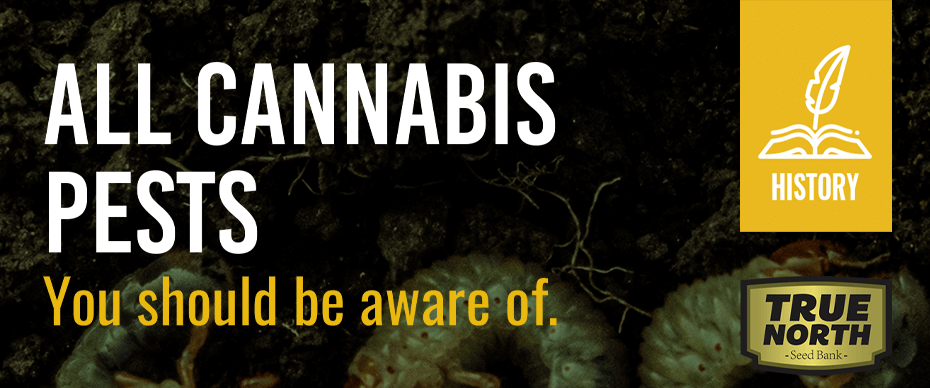
Cannabis, like any other plant, can be subjected to pests. If your plants are left untreated, pests can cause rapid devastating effects to your crop
Cannabis pests exist in different forms and can be classified into two categories, namely arthropods and mites. By feeding off of your crop, pests weaken or even kill cannabis plants.
From tiny insects to rodents, your cannabis plants are at the mercy of various pests. Indoor growing is an excellent option at minimizing pest exposure, but there are specific guidelines you need to follow.
Whether you're growing cannabis from seed or clone, pest managment is essential.
Below you will find all the information about different types of pests and what to do to protect your cannabis plants against them. Let’s dive in!
Types Of Cannabis Pests
There are two main types of cannabis pests: arthropods and mites.
In a recent review by California Agriculture in 2019, growers recorded fourteen separate arthropods and nine vertebrates wreaking havoc on their cannabis crops.
Arthropods
Arthropods are insects, crustaceans, or arachnids, usually characterized by their segmented body.
Below is a list of the three common arthropod cannabis pests:
Thrips
Thrips are minute, slender insects with fringed wings and unique asymmetrical mouthparts.
Larvae
A period in the life of many animals that occurs after birth or hatching but before they reach adulthood.
Grasshoppers
Grasshoppers are herbivorous insects of the suborder Caelifera in the order Orthoptera.
Mites
Mites are tiny arachnids. Mites are not a defined taxon, but the name is used for members of several groups in the subclass acari.
Below are some common types of mites:
- Russet mites
- Spider mites
- Broad mites
- Red mites
- Other mites
The most common arthropod pest was mites by 70%, succeeded by thrips at 25% and aphids at 17%.
In contrast, gophers, rats, and deers were the most common vertebrate from the study.
Can Cannabis Pests Strike On Indoor Grow?
Yes, pests can strike on indoor grows in some cases.
A review by Colorado State University, states hemp russet mites are a common pest when producing cannabis indoors.
Along with the hemp russet mite, the two-spotted spider mite is a typical indoor cannabis pest mainly found throughout Colorado's lower elevations.
According to G. K. Mahapatro in 2017, termites can also be a problem with indoor cannabis production.
If your crop is pest infested, here are the steps to stop their propagation:
- Stop further damage: Ensure that your grow room is thoroughly sanitized, including the soil, equipment, and air supply.
- Keep the area clean: When entering your growing site, always wash your hands and wear clean clothes.
- Restrict access: Do not let anyone enter, even your pets, especially when your plants are not yet matured.
While mites are the most common pests for indoor growth, aphids, leafhoppers, scales, and mealybugs are common pierce-sucking insects found in greenhouses.
Tips To Identify Cannabis Pests
Did you know that growing cannabis with other plants can help mitigate pest damage to your crop?
According to the Journal of International Hemp Association, a quick way to identify cannabis pests is by inspecting the plant.
Based on the damage, you can identify the pest responsible for your infested crop.
First, if there are cankers on the stem, this can indicate the presence of European corn borers or hemp borers.
When borers feed themselves, they weaken the stem and promote the formation of cankers.
Other insects may also feed on the stem, for example, beetles, maggots, and weevils.
If the flowering parts are damaged, it could result from budworms.
They usually cause a lot of destruction on the flowering buds but no damage on the leaves or stem.
However, it should be noted that European corn borers and hemp borers can also cause damage to flowering parts.
In contrast, the most severe damage to the root is caused by the flea beetle grubs and white root grubs.
Some minor root pests also include ants, termites, fungus gnats, root maggots, and wireworms.
In the case of the leaves, yellow or white spots on the leaf might indicate the passage of spider mites.
Aphids also attack the leaves by assembling on the backside of the leaves.
They make the leaves wilt and turn yellow, which can cause the whole plant to be wilt and perish.
Besides, you should note that the flea beetle grubs and white root grubs that attack the roots can also feed on the leaves.
The Three Most Common Types Of Cannabis Pests
Below is a list of the most common types of pests found in cannabis crops:
Spider Mites
Spider mites are distinguished by their distinctive appearance; small oval bodies with six to eight limbs, and by the spin webs, they construct to safeguard their offspring.
Spider mites also leave yellow or white spots on the leaves after chewing the chlorophyll of the cannabis leaves.
The chlorophyll munched away by numerous bites can result in severe injury to the plants or even death.
Their web is very sticky and difficult to remove, which can cause a problem during the harvest.
Aphids
Aphids are small insects with yellow wings that live under cannabis leaves.
The resulting leaves would look yellow and wilted because aphids absorb nutrients from the cannabis plant.
When aphids consume cannabis plants, their excrement attracts ants, resulting in an even worse infestation.
Fungus Gnats
Fungus gnats are small black bugs that swarm around the ground and the lower part of your cannabis plant.
They have a gloomy forehead, a translucent body, and are just 3-5 millimeters long.
Females lay their eggs in damp soil a few inches deep, and larvae are often found in run-off.
Fungus gnats may not consume any portion of the cannabis plant above ground, but they will damage the roots and decrease soil drainage.
What To Do Against Cannabis Pests?
According to the California Agriculture study in 2019, researchers observed that the most popular pest control method was to apply a solvent or pesticides to the plants.
The second most common method was natural enemy augmentation.
A large number of sprays used were biologically generated or licensed for use in eco-agriculture.
The study found that azadirachtin, pyrethrins, and soap solutions were commonly used to combat arthropod pests.
Besides, many people said that products such as microbial pesticides, compost tea, and oils had positive results against pests and infections.
Other cultivators said they used certified organic pest control products but didn't mention which ones.
Some growers added natural predators, such as lady beetles, to boost natural enemies for pests.
The study also found that insect trapping, intercropping, and selecting resistant cultivars were efficient methods in removing pests infestation among cannabis crops.

About the author: Joe Powers
After an incident in the military, in 2011, Joe Powers began investigating cannabis by talking with industry leaders. In 2016, Joe launched Hemp Writer with its first publication in clarifying disinformation on specific updates to certain federal CBD laws.
Upon calling out a leading cannabis law firm spreading dis-info, Hemp Writer established itself as an authority in clarifying updated information emerging from the cannabis industry. Joe continues charging forwards with increasing momentum to continue fulfilling his vision of SHARING ACCURATE CANNABIS INFORMATION.










